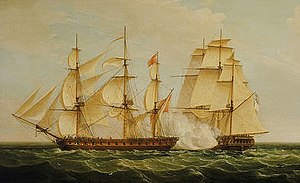HMS Pearl (1762)

HMS Pearl battles the Santa Monica off the Azores in 1779
|
|
| History | |
|---|---|
|
|
|
| Name: | HMS Pearl |
| Ordered: | 24 March 1761 |
| Cost: | £16,573.5.4d |
| Laid down: | 6 May 1761 |
| Launched: | 27 March 1762 |
| Completed: | 14 May 1762 |
| Commissioned: | April 1762 |
| Fate: | Sold 1832 |
| General characteristics | |
| Class and type: | Niger-class fifth-rate frigate |
| Tons burthen: | 683 16⁄94 (bm) |
| Length: |
|
| Beam: | 35 feet 3 inches (10.7 m) |
| Depth of hold: | 12 feet 0 inches (3.7 m) |
| Propulsion: | Sails |
| Sail plan: | Fully Rigged Ship |
| Complement: | 220 |
| Armament: | |
HMS Pearl was a 32-gun fifth-rate frigate of the Niger-class in the Royal Navy. She was launched at Chatham in 1762 and served in British North America until January 1773, when she sailed to England for repairs. She returned to North America in March 1776 to take part in the American Revolutionary War and escorted the troops which landed in Kip's Bay that September. Towards the end of 1777, Pearl joined Richard Howe's fleet in Narragansett Bay and was still there when the French fleet arrived and began an attack on British positions. Both fleets were forced to retire due to bad weather and the action was inconclusive. Pearl was then dispatched to keep an eye on the French fleet, which had been driven into Boston.
Pearl was present when the British captured the island of St Lucia in December 1778; she was chosen to carry news of the victory to England, capturing the 28-gun frigate Santa Monica off the Azores on her return journey. Pearl joined Admiral Marriot Arbuthnot's squadron in July 1780 and captured the 28-gun frigate Esperance while stationed off Bermuda in September. In March 1781, Pearl took part in the first battle of Virginia Capes where she had responsibility for relaying signals. At the end of the war in 1782, Pearl returned to England where she underwent extensive repairs. She did not serve again until 1786 when she was recommissioned for the Mediterranean.
Pearl was taken out of service in 1792, then recalled when hostilities resumed between Britain and France in February 1793. On her return to America, she narrowly escaped capture by a French squadron anchored between the Îles de Los and put into Sierra Leone for repairs following the engagement. In 1799, Pearl joined George Elphinstone's fleet in the Mediterranean where she took part in the Battle of Alexandria in 1801. In 1802, she sailed to Portsmouth where she served as a slop ship and a receiving ship before being sold in 1832.
...
Wikipedia
